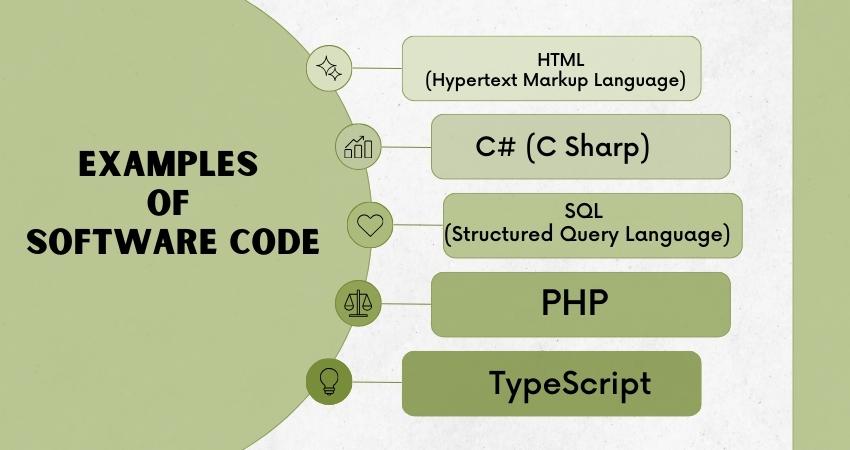In the dynamic realm of software development, understanding various types of code is crucial for aspiring developers and seasoned professionals alike. Whether you’re delving into the intricacies of web development, mobile app creation, or system architecture, a diverse knowledge of software code is indispensable. In this article, we’ll explore 25 examples of software code, offering insights into their applications and significance in the tech landscape.
Also Read: Examples of Programming Language
25 Examples of Powerful Software Code
Powerful examples of software code are deeply discussed in given below;
1. HTML (Hypertext Markup Language):
HTML, the backbone of web development, structures content on the internet. Active developers utilize HTML to create web pages, defining elements such as headings, paragraphs, and links.
2. CSS (Cascading Style Sheets):
CSS complements HTML by styling web pages, ensuring a visually appealing and user-friendly experience. It dictates the layout, colors, and fonts, enhancing the aesthetics of a website.
3. JavaScript:
As a versatile scripting language, JavaScript enables dynamic content and interactivity on web pages. Developers leverage JavaScript to create responsive user interfaces and enhance user experience.
4. Python:
Known for its readability and versatility, Python is a high-level programming language used in web development, data analysis, artificial intelligence, and more. Its simplicity facilitates rapid development.
5. Java:
Java, an object-oriented programming language, is widely used in building enterprise-level applications, mobile apps (Android), and large-scale systems. It ensures cross-platform compatibility.
6. C# (C Sharp):
Developed by Microsoft, C# is integral to building Windows applications, web applications using ASP.NET, and game development using the Unity game engine.
7. C++:
C++ combines low-level and high-level programming features, making it ideal for system/software development, game development, and performance-critical applications.
8. PHP:
PHP is a server-side scripting language commonly used for web development. It powers dynamic websites and interacts with databases, making it an essential tool for content management systems like WordPress.
9. Ruby:
Ruby, known for its elegant syntax, is employed in web development frameworks like Ruby on Rails. Its focus on simplicity and productivity makes it a favorite among developers.
10. Swift:
Developed by Apple, Swift is the programming language for iOS, macOS, watchOS, and tvOS app development. It is renowned for its speed and safety features.
11. Kotlin:
An official language for Android app development, Kotlin is praised for its conciseness and interoperability with Java. It enhances developer productivity and reduces boilerplate code.
12. TypeScript:
Built on JavaScript, TypeScript adds static typing to the language, making code more robust and scalable. It is particularly beneficial for large codebases.
13. SQL (Structured Query Language):
SQL is the language for managing and manipulating relational databases. Developers use SQL to retrieve, update, and manipulate data, ensuring efficient database operations.
Also Read: 10 Examples of SQL Commands
14. Shell Scripting:
Shell scripts, written in languages like Bash, automate repetitive tasks in the Unix/Linux operating system. They are powerful tools for system administrators and developers.
15. Go (Golang):
Developed by Google, Go is appreciated for its simplicity and efficiency. It is commonly used in building scalable and concurrent systems, making it suitable for cloud-based applications.
16. Rust:
Rust prioritizes memory safety without sacrificing performance, making it ideal for systems programming. It’s widely used in projects where low-level control is crucial.
17. MATLAB:
MATLAB is a powerful language for numerical computing, widely used in academia and industry for tasks such as data analysis, simulation, and algorithm development.
18. R:
Specializing in statistical computing and graphics, R is favored by data scientists and statisticians for its extensive libraries and visualization capabilities.
19. Assembly Language:
At the lowest level, assembly language provides a direct interface with the computer’s hardware. It is crucial for tasks requiring fine-grained control over system resources.
20. Shell Scripting:
Shell scripts, written in languages like Bash, automate repetitive tasks in the Unix/Linux operating system. They are powerful tools for system administrators and developers.
21. Objective-C:
While Swift has gained popularity, Objective-C remains essential for iOS and macOS app development. It seamlessly integrates with Swift, offering backward compatibility.
22. HTML5 and CSS3:
Evolved versions of HTML and CSS, HTML5 introduces new elements and features for multimedia, while CSS3 enhances styling capabilities, ensuring a richer user experience.
23. XML (eXtensible Markup Language):
XML is a versatile language for encoding documents in a format that is both human-readable and machine-readable. It is commonly used for data interchange between applications.
24. Dart:
Developed by Google, Dart is the language for building cross-platform mobile, web, and desktop applications using the Flutter framework. It combines ease of development with high performance.
25. GraphQL:
GraphQL is a query language and runtime for APIs that empowers developers to request specific data, reducing over-fetching and under-fetching of data in web applications.
Thank you for checking out these examples! I’m glad I could be of help. If you found this content valuable, please leave a comment to let me know. Your feedback is greatly appreciated!

